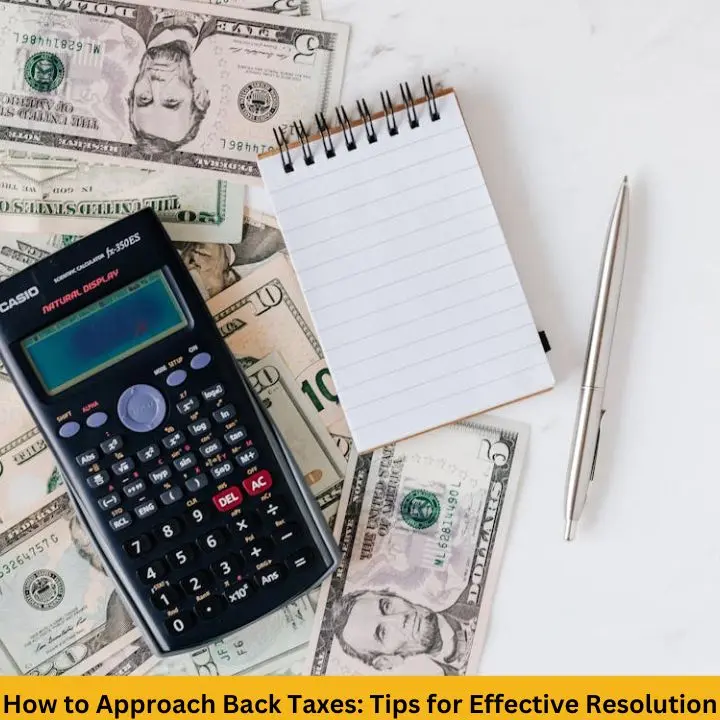How to Approach Back Taxes: Tips for Effective Resolution

When the topic of taxes comes up, most people would rather change the subject. But when back taxes enter the conversation, it becomes even more uncomfortable. The IRS doesn’t just forget unpaid taxes; ignoring them can lead to penalties, interest, and even legal trouble. Therefore, dealing with back taxes is essential for financial stability and peace of mind. In this article, we’ll explore practical ways to handle back taxes effectively so you can regain control of your finances. It’s important to remember that individuals and businesses face tax challenges, and understanding the appropriate strategies, like knowing the business tax rate—is crucial to tackling the problem head-on.
Understanding the Root of the Problem
Now that we have looked at strategies for paying back taxes, it is paramount to look at why back taxes are paid in the first place. Back taxes often pile up for various reasons: lack of attention or negligence, misestimation of income or even inflating, or merely omission arising from financial difficulties. In many cases, taxpayers are in a critical financial position and decide that their tax issues will sort themselves out or disappear independently. Unfortunately, this only aggravates it.
The first of those steps involves taking a step back and looking at your past financial and tax situation. Collect all your tax-related papers, invoices, and bank statements. It will assist you to know the exact amount owed and whether there are other charges that you never knew existed or discounts given that could have been missed. This is why it is essential to understand the quantum and the character of the tax debt in detail. From this point, you can move to discussing the available payment and negotiation opportunities.
Develop a Plan of Action
Understanding your situation is the primary step. Once you’ve done this, you should be able to devise the right approach to paying off your back taxes. Here’s how to approach this step-by-step:
File Your Late Returns
When you cannot pay the amount in full, filing delinquent tax returns as soon as possible is still important. The IRS usually penalizes non-filing, and these penalties are generally worse than non-payment penalties. When you file your tax returns, you are willing to pay the amount owed. This is advantageous when negotiating how to pay the amount owed to the IRS. If needed, it is advisable to seek the services of a tax consultant to help check that all the returns filed are correct and that all possible exemptions are taken to minimize the amount paid.
Consider Your Payment Options
Following filing, comes the payment issue to the deserving party/ies. The IRS provides several tools for people to address their tax problems. If you cannot pay the total amount at once, you can look into options such as:
Installment Agreements: This option enables a person to pay the amount of tax in monthly installments. Although interest and penalties will continue to be charged, this option helps spread the cost over time, which is less painful.
Offer in Compromise: Sometimes, the IRS will allow a taxpayer to pay less than the amount they owe due to financial difficulties. This is referred to as an Offer in Compromise (OIC). It is important to note that a valid OIC application involves submitting a number of documents that support the fact that one cannot afford to clear the entire balance.
Currently Not Collectible Status: If your financial situation is really bad, you can apply for the ‘currently not collectible’ status. This suspends collection activities for a while, but interest and penalties continue to be charged. While this is also not a permanent solution, it can help you have some time to sort out your financial situation.
Seek Professional Assistance
If you realize that you are stuck at some point, consult a tax professional. Tax laws are not simple, and every case may differ from one another. A certified tax advisor or resolution specialist can review your financial profile, consider all strategies, and then create a specific plan for dealing with the tax issue. They can also deal directly with the IRS to handle your case or solve some problem without your participation.
Another benefit of hiring a professional is their awareness of the recent changes in the tax laws, which may influence how much one is entitled to pay or present new ways of escaping that obligation. Besides, they can advise you on how to proceed with negotiations if you have applied for an Offer in Compromise or an installment agreement, thus improving your chances of being approved. Hiring the services of a professional means that you are more likely to aggravate your situation by making the right decisions.
Plan for the financial future.
Paying back taxes is merely the first step – you also have to devise a strategy of not repeating the same mistake. The first step is always to look at your current behaviors and actions regarding money. Prepare a feasible budget that estimates all of your expenditures, including regular tax payments. It will also be wise to open a separate account to save taxes so you do not lack money during this season.
Don’t Let Fear Hold You Back
It is always scary to face back taxes, but the best thing to do is to deal with it as early as possible since it will not be as easy as anyone might think. The IRS is more likely to be polite to those who try to pay back what they owe. Knowing your rights, filing the tax return even after the deadline, and making a schedule of how you will pay your debts will help you get back on track and prevent additional penalties from being charged.
In summary, the key to effectively approaching back taxes is to act promptly and stay informed about your financial situation. Whether you work through the process independently or seek professional help, taking the necessary steps today can lead to a more secure financial future. Don’t let back taxes weigh you down—start your journey to resolution now and pave the way for financial peace of mind.
For More: Fameimpact




